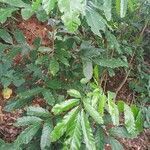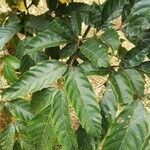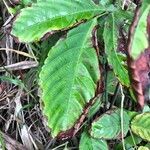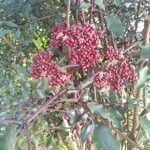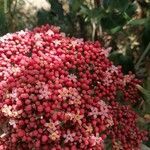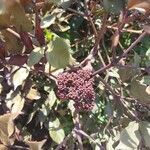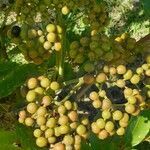Softly woody shrub with fleshy jointed stem or climber or can be unbranched and ± herbaceous, 0.4–3 m. tall; outside the Flora area sometimes a shrub or tree 1–5(–10) m. tall; branches usually glabrous but rarely pubescent to densely hairy or papillose.. Leaves (1–)2–3(–4)-pinnate; leaflets 3–7 per pinna; petiole (5–)10–20(–25) cm. long; rhachis (10–)25–75(–100) cm. long; petiolules 1.5–4 cm. long; stipules obovate, 2–4(–6) cm. long, (1–)1.5–3 cm. wide, soon deciduous, glabrous to woolly; leaflets ovate or elliptic to oblong or elliptic-lanceolate, the terminal one more elliptic and the laterals mostly narrower and more oblong, (3–)8–20(–30) cm. long, (1.5–)3–8(–14) cm. wide, acuminate at the apex, cuneate to rounded or truncate at the base, mostly ± glabrous, less often pubescent or hispid, repand to denticulate at the margins.. Inflorescences (3–)10–25(–40) cm. long, lax to condensed, glabrous to rusty pubescent; pedicels 1–2 mm. long; bracts ovate to narrowly triangular, up to 3 mm. long; axes pink to crimson.. Calyx orange-red, 1–3 mm. long, 2–4 mm. wide, glabrous or pubescent; lobes 1–2 mm. long and wide.. Corolla yellow or orange to red; tube 3–5 mm. long; lobes 2–4 mm. long, 1–2.5 mm. wide.. Staminodial tube pale yellow, (1.3–)2–3 mm. long.. Ovary (4–)6(–8)-locular; style cream, 1–2.5 mm. long.. Fruit orange, red, dark red or purplish to black, 0.5–1.5 cm. in diameter.. Seeds 6 × 5 × 4 mm., with simply ruminate endosperm.. Fig. 26.
A shrub or small tree. It grows 5-8 m high. The leaves are alternate. They are 25-80 cm long. They vary in shape, even on a single plant. They can be simple, or divided once or twice into leaflets. The leaf stalk is usually rounded. The upper end of the leaf stalk has a groove. The leaflets can be oval, rounded or wedge shaped. The leaflet at the end is larger than the side leaflets and on a longer stalk. The flower clusters occur opposite leaves and have a flat top. They can be 10-20 cm across. The flowers are greenish-white and individual flowers are 7-8 mm across. The petals eventually curve backwards. The fruit are flattened, round berries which have 4-6 lobes. They are 9-12 mm across. They are a dull green. There are 4-6 seeds inside. The fruit are edible. (The leaves and flowers are a little like elder.)
Shrubs or small trees. Branchlets terete, almost glabrous. Leaves 2-or 3-pinnate; petiole 6-13 cm, central petiolules 1.5-4 cm, lateral petiolules 0.5-1.5 cm, glabrous; leaflets oval elliptic to long and roundly lanceolate, 5-15 × 2.5-8 cm, base broadly cuneate, or rarely suborbicular, margin with acute teeth, apex acuminate, glabrous; lateral veins 6-11 pairs, abaxial veinlets conspicuous but not protruding. Inflorescences a corymboselike compound dichasium, ca. 50 cm in diam. Pedicel very short or nearly none, sparsely with papillary hairs; buds ca. 3 mm. Calyx tube cupulate; sepal triangular, with an acute apex, glabrous. Petals 5, elliptic, red. Stamens 5; filaments 1.2-1.6 mm; anthers yellow. Ovary ovate; stigma expanded slightly. Berry subglobose, ca. 0.8 cm in diam.
Leaves bipinnate or occasionally tripinnate at the base; petiole c. 12 cm. long, glabrous or pubescent; rhachis with reddish swellings at the insertion of the pinnae in the fresh state but these swellings changing to constrictions in herbarium specimens; stipules 2–4 × 1–3 cm., very caducous; pinnae 5; leaflets 3–5(7), imparipinnate, opposite, petiolule to 2 mm. long, leaflet-lamina 4–20 × 2–7 cm., elliptic, acuminate at the apex, margin serrate-dentate, rounded at the base, somewhat discolorous, glabrous or occasionally pubescent on the nerves on the lower surface; nerves prominent below.
Cymes usually 2-branched from the base, up to 20 cm. across; branches reddish, pubescent or glabrous; bracts and bracteoles c. 0·5 × 0·5 mm., triangular, very caducous, glabrous; pedicels c. 0·5 mm. long, glabrous or pubescent.
Fruits red turning black when ripe, up to 8 mm. in diam., glabrous with a persistent calyx.
Flowers globose in bud, 2–5 mm. in diam., red outside, orange or yellowish inside.
Ovary ovoid, 4–6-locular; style c. 2·5 mm. long; stigma subglobose-capitate.
Staminal tube with 5 truncate 2-dentate lobes, shorter than the petals.
Shrub c. 1 m. tall or a tree up to 10 m. tall (outside our area).
An erect or suberect soft-wooded shrub, up to 20 ft. high
Calyx 1·5 mm. long, glabrous or pubescent.
Fruits brilliant red then turning black
Seeds c. 4 × 3 mm., brownish, smooth.
Flowers bright yellow, orange or red
Corolla c. 5 mm. long, glabrous.
Branches soft-wooded, glabrous.
